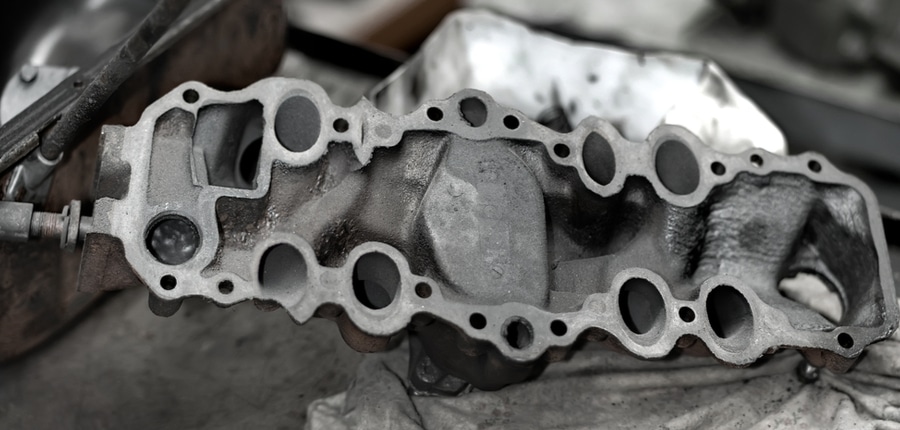The combustion cycle involves pulling an air/fuel mixture into the cylinder head through the intake valves, igniting the mixture, and then expelling it out the exhaust valves. At the exhaust ports of the cylinder head, a cast iron exhaust manifold is bolted, which combines and directs the gases into the exhaust system.
Some 4-cylinder engines integrate the exhaust manifold with a front catalytic converter (sometimes called a pre-cat). In that case, it’s usually welded steel rather than cast iron. A gasket seals the junction between the exhaust manifold and the cylinder head.
Costs of Exhaust Manifold Gasket Replacement
Some estimates of the cost to replace exhaust manifold gasket are illustrated below using common vehicles at $100 an hour labor rate:
- For a 2005 GMC Sierra 1500 4WD with a 5.3L engine, the labor time to replace either the left or right exhaust manifold gasket is estimated at 1.5 hours. A factory manifold gasket costs about $8, and a set of exhaust bolts costs about $16. The total cost would be about $174 to replace either exhaust manifold gasket.
- For a 2010 Ram 1500 4WD with a 5.7L engine, the labor time to replace the left exhaust manifold gasket is estimated at 1.8 hours. A factory manifold gasket for the left side is about $26, and an Apex gasket costs about $16. Adding about $20 for hardware, the total cost to complete the job would be about $226 using factory parts, or about $216 using aftermarket parts. To replace the right side exhaust manifold gasket, the labor time is estimated at 1.6 hours. A factory manifold gasket for the right costs about $26, and an Apex gasket costs about $16. With hardware, the job would cost about $206 using factory parts, or about $196 using aftermarket parts.
- For a 2004 Toyota Camry with a 2.4L engine, the labor time to replace the exhaust manifold gasket is estimated at 1.5 hours. A factory gasket costs about $30, and a Mahle gasket costs about $16. The total cost to complete the job would be about $180 using factory parts, or about $166 using aftermarket parts.
- For a 2009 BMW 328i with a 3L engine, the labor time to replace the exhaust manifold gasket is estimated at 6 hours for the front (left side), and 4.3 hours for the rear (right) side. A factory gasket set costs about $24, and a Mahle set costs about $12. The total cost to replace the front side gasket would be about $624 using factory parts, or $612 using aftermarket parts. For the rear side gasket, the job would cost around $454 using factory parts, or about $442 using aftermarket parts.
If an exhaust manifold has known broken bolts at the time the exhaust manifold gasket repair cost estimate is written, it is fairly normal to have about an hour of labor added to the job estimate for each bolt. If bolts break during the work, then, usually, the customer is informed of the additional unexpected work necessary.
On the above examples, the normally replaced hardware is included, but sometimes, there are additional items. Exhaust bolts and nuts are very prone to heat stress and rust and aren’t often re-usable.
Exhaust Manifold Gasket Replacement
The exhaust manifold is subject to a great deal of heat stress, which leads to its main type of failure – it can warp. When the manifold warps, that puts a lot of stress on the bolts that hold it down.
This can lead to stretched or broken bolts and the failure of the gasket between the manifold and the head where it must hold exhaust pressure. Replacement of the gasket involves removing the bolts that attach the manifold from the cylinder head and generally removing the manifold to get it out of the way.
On a few engines, the manifold is on the front and reasonably easy to access. However, more often, removing the exhaust manifold is a difficult job; often accessed through the wheel wells on a longitudinal engine, or from underneath the back of a transverse engine.
Addressing a Warped Exhaust Manifold
The main cause of an exhaust manifold gasket failure is a warped exhaust manifold. When an exhaust manifold gasket needs to be replaced, then, the exhaust manifold itself should be checked and measured for trueness.
If the mating surface of the manifold to the cylinder head isn’t flat (and they often aren’t), then, it won’t seal well. The stresses upon the bolts that will be required to tighten it down will be excessive, and the cause of the initial failure will not have been corrected.
The least-cost solution is to have the manifold resurfaced at a machine shop if that is needed. If there are no cracks or excessive rust issues, this is usually considered a permanent repair, and it’s usually cheaper than replacing the manifold.
Probably the main reason it isn’t often done is time; the old part must be removed and sent out, and machine shops often have backlogs of work.
If a vehicle is needed and it takes a week to get the job done, the cost of a vehicle rental easily becomes higher than the job itself. But if time isn’t an issue, then, it is usually a reasonable way to save costs.
The cost to resurface an exhaust manifold, once it’s off the vehicle, runs from about $40 to $100.
The other alternative is to replace the exhaust manifold. On the GMC 5.3-liter engine, for example, new factory exhaust manifolds cost about $230 each, and aftermarket manifolds cost about $54 each.
For the Dodge 5.7-liter engine, the cost of factory exhaust manifolds is about $160 each, and aftermarket manifolds cost about $110 each.
On vehicles with welded steel manifolds rather than cast iron (such as the Toyota or BMW examples), the surfaces are much less prone to warping, and much less often, the initial cause of a gasket failure.
Other Things That May Come Up

The other main issue that comes up with exhaust manifold gasket replacement is the broken exhaust bolts. On some engines, they break only rarely. However, on other engines, it is a very common occurrence.
The lower bolts that hold the exhaust manifold to the exhaust pipe are a little trouble. Usually, they are either “free” bolts that can simply be replaced with new hardware, or they are studs that are part of the manifold itself. A new manifold comes with new studs.
The bolts that hold the exhaust manifold to the cylinder head are another story, and it’s usually not possible to predict in advance how difficult the job may be. In the best case, a bolt will break with enough length past the cylinder head surface that it can be gripped by a stud extractor and rotated out.
More commonly, they will break off flush with the cylinder head surface. The usual procedure then is to drill a small hole into the middle of the bolt, hammer in an extraction tool, and rotate the bolt out.
One of the difficulties of this is that the initial drilled hole needs to be precisely centered and drilled straight. This is often difficult or impossible due to tight access or non-removable parts being in the way.
Another way of extracting a flush-broken bolt from a cylinder head is to weld a nut to it, so it can be turned out like a normal bolt. This is the usual practice where a bolt is inaccessible to a drill.
Welding is also a very skill-dependent thing. A very good welder might immediately and cleanly get the job done, but a less skilled welder might fail repeatedly to get a strong enough bond. The heat involved in repeated attempts can damage the cylinder head.
In the worst case, whether the drilling out didn’t work or the welding, a cylinder head might need to be removed to fix the bolt hole on a workbench. Machine shops also regularly repair cylinder heads for this kind of problem if a shop is unable to.
Drill-guide fixtures are available for many engines, and helicoil inserts can be installed to restore threads if a drilling job went badly. However, removing the cylinder head adds many hours to the job, and requires new gaskets, head bolts, and fluids to complete the reassembly at a significant cost.
On some vehicles that have specific common issues with broken exhaust bolts, there are repair clamps available. If an exhaust manifold gasket is being replaced, a repair clamp is a way of avoiding the time and expense. This is whether the manifold is being replaced or resurfaced and if a broken bolt can’t be extracted without removing the cylinder head.
A clamp bolts to the rear or front surface of the cylinder head and has a heavy steel angle that holds a bolt which bears down on the end of the exhaust manifold. This allows a broken bolt to be left in place and the exhaust manifold still held secure.
An example of that would be if the GMC in the example above had a broken driver-side rear exhaust bolt; a common issue and very hard to access. A Dorman repair clamp for that spot costs about $26 and takes about 1.5 hours to install. The job might cost about $176 and can avoid the larger possible expenses of dealing with the broken bolt.

